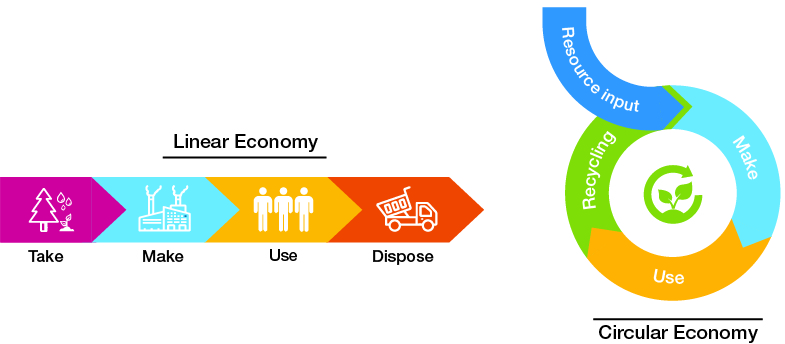Business Value in a Circular Economy
In Product Development, the only constant is change. As Lao Tzu so eloquently put it: “If you do not change direction, you may end up where you are heading”. Learning leads to insight, which inspires change. Ignorance does not. That’s why at Locus, a learning culture is essential, and one that we embrace.
I’m currently completing a course on the Circular Economy. It’s run through the edX platform, and led by TU Delft and co-created with the Ellen MacArthur Foundation and the Leiden-Delft-Erasmus Centre for Sustainability. I thought I would share some of my learning so far about business value in a circular economy.
It doesn’t take much to see that our economies have become so large that the natural ecosystem is under pressure.
In the predominant linear economy, one of take – make – use – dispose, the natural ecosystem has to be the source of raw materials and the sink for waste. In a circular economy, one of make/remake – use/reuse, the goods of today become the resources of tomorrow. The extraction of raw materials and the production of waste is drastically limited by recovering and reusing as many products and materials as possible in a systematic way over and over again.

I can appreciate that for most key decision-makers, the motivation to move to a circular economy, requires the assurance of increased business value (not just a commitment to the environment). So let’s look at some of the ways increased value could be achieved.
Firstly, how does a business become circular?
To become circular, a company needs to close the loop in three main business processes:
- Acquisition – collect the right volumes of products or materials of the right quality, for a reasonable price.
- Reprocessing – refurbish, remanufacture or recycle used products or materials, for a reasonable price.
- Remarketing – identify markets that want to buy the reprocessed products or materials.
If any of these processes fail, we don’t have a closed-loop. It’s worth noting that closing the loop on the product or part level potentially generates much more value than on a material level.
What are some of the ways a circular economy can create business value?
Sourcing value
Direct cost reductions and savings can arise from closed-loop business practices (think refurbished products or recycled materials)
Environmental value
Once you have your sourcing value in place, you will have a reduced footprint, and this should be communicated through. If you don’t communicate this to your stakeholders there is no business value. This refers to both ease of compliance and an improved green image.
Customer value
Once you have a reverse supply, you can offer certain services to your customers that increase customer loyalty and satisfaction. e.g. you make it easy for them to return products or turn in their product for a new product or offer a new range of products that are refurbished, and of course more environmentally friendly products. This all increases customer value.
Informational value
When you take back your products you have the opportunity to thoroughly inspect them. You can gain valuable data on production and supply problems, failure rates, the useful lifetime of the product, consumer complaints, and usage patterns. This can be used to improve different processes including product design and production etc.
Business Models in a Circular Economy
We can identify three different categories of product-service business models:
1. Product-Oriented – the business model is geared towards the sales of products. Some extra services may be added such as financial coverage or a maintenance contract etc.
2. Use-Oriented (Access model) – In this business model, the product still plays a central role. It is owned by a provider and is made available to a client. E.g. a car-sharing service where you buy access to a car rather than owning the car yourself.
3. Result-Oriented (Performance model) – This is a model where the client and the provider agree on a result. There is no predetermined product involved.
A true circular economy business model is result-oriented. So this is where the rubber hits the road; making the shift from a product-oriented business model to a results-oriented business model. Not an easy change. Some of the key challenges of moving towards a results-oriented business model include the need to organise maintenance, repair, and acquisition, and of course, the need to change the “sell more, sell faster” culture of an organisation. Not an easy feat.
But, if you don’t do it and there is value to be made on the market, your competitor will do it.
Read some case studies of businesses making the shift here:
www.ellenmacarthurfoundation.org/case-studies
Sign up for the “Circular Economy: An Introduction” course here:
www.edx.org/course/circular-economy-an-introduction-2
Want to read more on creativity, design, product development and innovation? Go to our Six Lenses Blog.


Comments